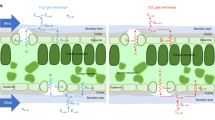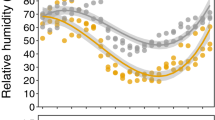Summary
It is frequently observed that liquid-exchange methods of measuring tissue water potential,Ψ, yield estimates further from zero than those obtained with vapour exchange methods, and that a similar situation exists with respect to plasmolytic methods of measuring vacuolar osmotic pressure,π, compared with estimates from expressed sap methods. Although a number of factors may contribute to this phenomenon, it is suggested that the underlying reason is one of membrane leakiness, in the liquid exchange methods, to the solutes commonly employed. Although the amount of solute uptake may appear to be small during the period of the determinations, the effective osmotic pressure of the external solution is reduced if there is a net volume exchange of water and solute, instead of a simple water exchange. Thus the solution which appears to be in equilibrium with the tissue is, in fact, more concentrated than the true equilibrium solution leading to a spurious estimate of Ψ or π.
Similar content being viewed by others
Literature
Barrs, H. D., 1964: Heat of respiration as a possible cause of error in the estimation by psychrometric methods of water potential in plant tissue. Nature203, 1136–1137.
Bennet-Clark, T. A., A. D. Greenwood, and J. W. Barker, 1936: Water relations and osmotic pressures of plant cells. New Phytol.35, 5–17.
—, and D. Bexon, 1940: Water relations of plant cells, II New Phytol.39, 337–361.
Broyer, T. C., 1951: Experiments on imbibition and other factors concerned in the water relations of plant tissues. Amer. J. Bot.38, 485–495.
Crafts, A. S., B. Currier, and C. R. Stocking, 1949: Water in the physiology of plants. Chronica Botanica, Waltham, Mass.
Currier, H. B., 1944 a: Water relations of root cells ofBeta vulgaris. Amer. J. Bot.31, 378–387.
Currier, H. B., 1944 b: Cryoscopy of small amounts of expressed tissue sap. Plant Physiol.19, 544–550.
Dainty, J., 1963: Water relations of plant cells. Adv. Bot. Res.1, 279–325.
—, and B. Z. Ginzburg, 1964: The reflection coefficient of plant cell membranes for certain solutes. Biochim. Biophys. Acta79, 129–137.
Ernest, E. C. M., 1935: Factors rendering the plasmolytic method inapplicable in the estimation of osmotic values of plant cells. Physiol. Plant.10, 553–558.
Gaff, D. F., and D. J. Carr, 1962: The role of cell wall water in the water relations of leaves. UNESCO Arid Zone Res.16, 117–126.
— —, 1964: An examination of the refractometric method for determining the water potential of plant tissues. Annals of Botany28, 351–368.
Hewlett, J. D., and P. J. Kramer, 1962: The measurement of water deficits in broadleaf plants. Protoplasma57, 381–391.
Katchalsky, A., and O. Kedem, 1962: Thermodynamics of flow processes in biological systems. Biophys. J.2, 53–78.
Kedem, O., and A. Katchalsky, 1958: Thermodynamic analysis of the permeability of biological membranes to non-electrolytes. Biochim. Biophys. Acta27, 229–246.
— —, 1963: Permeability of composite membranes, Part I: Electric current, volume flow and flow of solute through membranes. Trans. Faraday Soc.59, 1918–1930.
Kreeb, K., and M. Önal, 1961: Über die gravimetrische Methode zur Bestimmung der Saugspannung und das Problem des negativen Turgors. II. Mitteilung. Die Berücksichtigung von Atmungsverlusten während der Messungen. Planta56, 409–415.
Mason, T. G., and E. Phillis, 1939: Experiments on the extraction of sap from the vacuole of the leaf of the cotton plant and their bearing on the osmotic theory of water absorption by the cell. Ann. Bot. 3, 531–544.
Mees, G. C., and P. E. Weatherley, 1957: The mechanism of water absorption by roots I. Preliminary studies on the effects of hydrostatic pressure gradients. Proc. Roy. Soc.147, 367–380.
Mercer, F. V., 1955: The water relations of plant cells. Proc. Linn. Soc. NSW80, 6–29.
Meyer, B. S., and A. M. Wallace, 1941: A comparison of two methods of determining the diffusion pressure deficit of potato tuber tissues. Amer. J. Bot.28, 838–843.
Slatyer, R. O., 1958: The measurements of diffusion pressure deficit in plants by a method of vapour equilibration. Aust. J. Biol. Sci.11, 349–365.
- and E. Shmueli, 1966: Measurements of internal water status and transpiration. In: “Irrigation of Agricultural Lands” (in press).
Staverman, A. J., 1951: The theory of measurement of osmotic pressure. Rec. Trav. Chim.70, 344–352.
van Overbeek, J., 1942: Water uptake by excised root systems of the tomato due to non-osmotic forces. Amer. J. Bot.29, 677–683.
Weatherley, P. E., 1955: On the uptake of sucrose and water by floating leaf disks under aerobic and anaerobic conditions. The New Phytologist54, 13–28.
Author information
Authors and Affiliations
Rights and permissions
About this article
Cite this article
Slatyer, R.O. An underlying cause of measurement discrepancies in determinations of osmotic characteristics in plant cells and tissues. Protoplasma 62, 34–43 (1966). https://doi.org/10.1007/BF01254630
Received:
Issue Date:
DOI: https://doi.org/10.1007/BF01254630




